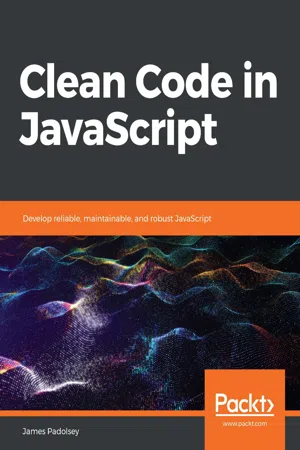
Clean Code in JavaScript
Develop reliable, maintainable, and robust JavaScript
- 548 pages
- English
- ePUB (mobile friendly)
- Available on iOS & Android
About this book
Get the most out of JavaScript for building web applications through a series of patterns, techniques, and case studies for clean coding
Key Features
- Write maintainable JS code using internal abstraction, well-written tests, and well-documented code
- Understand the agents of clean coding like SOLID principles, OOP, and functional programming
- Explore solutions to tackle common JavaScript challenges in building UIs, managing APIs, and writing states
Book Description
Building robust apps starts with creating clean code. In this book, you'll explore techniques for doing this by learning everything from the basics of JavaScript through to the practices of clean code. You'll write functional, intuitive, and maintainable code while also understanding how your code affects the end user and the wider community.
The book starts with popular clean-coding principles such as SOLID, and the Law of Demeter (LoD), along with highlighting the enemies of writing clean code such as cargo culting and over-management. You'll then delve into JavaScript, understanding the more complex aspects of the language. Next, you'll create meaningful abstractions using design patterns, such as the Class Pattern and the Revealing Module Pattern. You'll explore real-world challenges such as DOM reconciliation, state management, dependency management, and security, both within browser and server environments. Later, you'll cover tooling and testing methodologies and the importance of documenting code. Finally, the book will focus on advocacy and good communication for improving code cleanliness within teams or workplaces, along with covering a case study for clean coding.
By the end of this book, you'll be well-versed with JavaScript and have learned how to create clean abstractions, test them, and communicate about them via documentation.
What you will learn
- Understand the true purpose of code and the problems it solves for your end-users and colleagues
- Discover the tenets and enemies of clean code considering the effects of cultural and syntactic conventions
- Use modern JavaScript syntax and design patterns to craft intuitive abstractions
- Maintain code quality within your team via wise adoption of tooling and advocating best practices
- Learn the modern ecosystem of JavaScript and its challenges like DOM reconciliation and state management
- Express the behavior of your code both within tests and via various forms of documentation
Who this book is for
This book is for anyone who writes JavaScript, professionally or otherwise. As this book does not relate specifically to any particular framework or environment, no prior experience of any JavaScript web framework is required. Some knowledge of programming is assumed to understand the concepts covered in the book more effectively.
Frequently asked questions
- Essential is ideal for learners and professionals who enjoy exploring a wide range of subjects. Access the Essential Library with 800,000+ trusted titles and best-sellers across business, personal growth, and the humanities. Includes unlimited reading time and Standard Read Aloud voice.
- Complete: Perfect for advanced learners and researchers needing full, unrestricted access. Unlock 1.4M+ books across hundreds of subjects, including academic and specialized titles. The Complete Plan also includes advanced features like Premium Read Aloud and Research Assistant.
Please note we cannot support devices running on iOS 13 and Android 7 or earlier. Learn more about using the app.
Information
Section 1: What is Clean Code Anyway?
- Chapter 1, Setting the Scene
- Chapter 2, The Tenets of Clean Code
- Chapter 3, The Enemies of Clean Code
- Chapter 4, SOLID and Other Principles
- Chapter 5, Naming Things Is Hard
Setting the Scene

- What the true purpose of the code is
- Who our users are and what problems they have
- What it means to write code for humans
Why we write code
Code as intent
Take 185 grams dark chocolate
Melt it with butter over a saucepan
Break half dozen eggs, ideally large ones
Mix them together with a few cups of sugar
- What constitutes a large egg?
- When should I consider the butter fully melted?
- How dark should the dark chocolate be?
- How small is a small cube of butter?
- What does over a saucepan mean?
Who is the user?
function validatePostalCode(code) {
return /^[0-9]{5}(?:-[0-9]{4})?$/.test(code);
} - We, the programmers, who decided to use the shipping_address_validator package?
- The unwitting customers who are attempting to enter their addresses?
- The patients in the hospitals who are left waiting for their medication?
Table of contents
- Title Page
- Copyright and Credits
- About Packt
- Contributors
- Preface
- Section 1: What is Clean Code Anyway?
- Setting the Scene
- The Tenets of Clean Code
- The Enemies of Clean Code
- SOLID and Other Principles
- Naming Things Is Hard
- Section 2: JavaScript and Its Bits
- Primitive and Built-In Types
- Dynamic Typing
- Operators
- Parts of Syntax and Scope
- Control Flow
- Section 3: Crafting Abstractions
- Design Patterns
- Real-World Challenges
- Section 4: Testing and Tooling
- The Landscape of Testing
- Writing Clean Tests
- Tools for Cleaner Code
- Section 5: Collaboration and Making Changes
- Documenting Your Code
- Other Peoples' Code
- Communication and Advocacy
- Case Study
- Other Books You May Enjoy